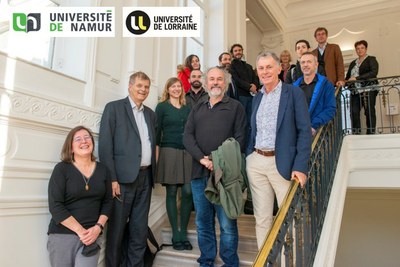The University of Namur signs a research partnership with the University of Lorraine
Cette nouvelle est également disponible en français ici...
Professor Patrick Kestemont, of the UNamur Environmental Biology Research Unit (URBE), ILEE Institute, collaborates regularly with Professor Pascal Fontaine, of the Animals and Animal Products Functionality Research Unit (UR AFPA) from the University of Lorraine. They have been partners in several European projects, notably the recent “Diversify”project.
|
At the front from left to right: Annick Castiaux, UNamur Rector - Karl Tombre, ULorraine Vice-President to international and european strategy - Isabella Fontana, Director of the UNamur International Relations Service - Prof Pascal Fontaine, ULorraine - Prof Patrick Kestemont, UNamur. On the top stairs, from left to right: Carine Michiels, UNamur Vice-Rector to Research - Jeroen Darquennes, UNamur Vice-Rector to International and External Relations - Nathalie Malengreau, UNamur Research office. |
When the University of Lorraine launches its call for IRP projects, the two researchers naturally contact each other to submit a joint project, which, after selection from among 17 applications submitted, is one of the 3 funded projects.
The aim of this research partnership is to involve more members of research units in inter-institutional collaborations and to bring together complementary skills. The research project will also fund a minimum of 3 theses, one of which is co-supervised and the other two are co-promoted.
The project
The URBE and UR AFPA are both experts in aquaculture. The aim of the project is to understand the effects of domestication on the reproduction and welfare of new species in aquaculture. The chosen model is the Zebra Fish. The fish will arrive from Bangladesh and will be in the wild. But we don't eat Zebra Fish, do we? So, why was this model chosen? First of all, because their genome is well known and a lot of bibliographic resources are available. Then, it is a species which reproduces quickly (a few months are enough to obtain a new generation). This enables to quickly analyze its resistance to stress and its reproduction in captivity. It should also be noted that the study plans to let the fish develop without making any selection, as is generally the case in farms. In this way, we can see whether domestication syndromes appear naturally, including phenotypic changes (appearance, morphology, levels of the stress hormone called cortisol, etc.).
“In the wild, fish are stressed when in the presence of a predator. They therefore produce adrenaline, which enables them to escape. In farming, fish should not be stressed each time humans approach the pond to feed them. Because stress can cause hormonal changes that would be harmful to the immune system», explains Patrick Kestemont. This will enable to observe what can improve their well-being and their reproduction. It can be transposed to species such as the perch and pike-perch, two species recently used for farming in Europe and still are little domesticated.
Pascal Fontaine adds: “During the first stages of its domestication, a species passes from a natural to a captive environment, often very artificialized, which constitutes a very sudden change in its living conditions. This transition can greatly stress animals and is often associated with mortality. Only animals with a strong adaptive capacity will survive. This transition period has been little studied, its consequences on the biology of organisms are unknown”.
The project also benefits from the support of the AQUA EXCEL2020 project, an H2020 project which brings together leading European research facilities in aquaculture and enables researchers to access the equipment through research projects.
The URBE will analyze samples from a molecular and physiological perspective, using its long-standing skills and expertise. On the equipment side, the team will also rely on the new AQUA platform, funded by the Walloon Region, which will bring together aquaculture research equipment from 3 French-speaking universities (UNamur, ULiège and UCL).
In the future, the partners hope to perpetuate their collaborations by being part of other joint projects and in particular of a European consortium which is being set up, and which aims to involve laboratory infrastructures.
The teams
|
University of Namur |
University of Lorraine |
|---|---|
|
• Patrick Kestemont, Full Professor • Frédéric Silvestre, Professor, • Valérie Cornet, post-doc researcher • Alexandre Erraud, post-doc researcher • Amélie Léonard, laboratory technician • Alice De Groote, laboratory technician • Jérôme Lambert, laboratory technician |
• Pascal Fontaine, Professor • Dominique Chardard, Associate Professor • Thomas Lecocq, Associate Professor • Sylvain Milla, Associate Professor • Bérénice Schaerlinger, Associate Professor • Marielle Thomas, Associate Professor • Gauthier Greiner, Contractual technical assistant • Daniel Krauss, Research engineer • Catherine Larrière, administrative and financial agent • Yannick Ledoré, Assistant engineer |
Contact: Patrick Kestemont












